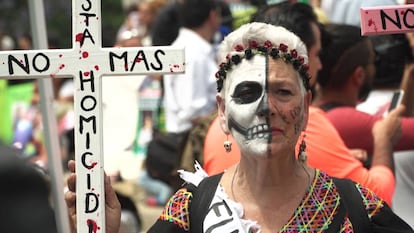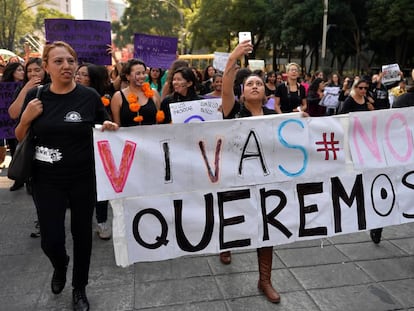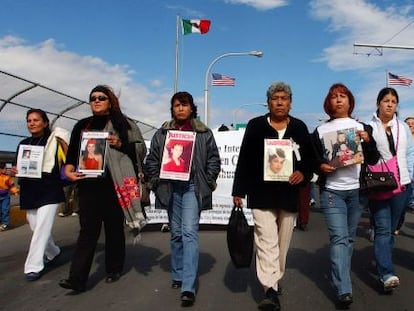Why are so many women being murdered in Mexico state?
Estimates put the number of femicides in this key industrial and political region at 263 in 2016

Amparo Vargas saw her daughter¡¯s murderer twice. The first time was inside the courthouse. The man who raped the young woman on the back seats of a bus, broke her neck and left her body under a bridge, all in under 40 minutes, was flanked by two police officers when she spotted him in a hallway. Vargas walked up to him and, instead of jabbing her pen in his neck, as the officers had expected, she simply asked him: ¡°Why?¡±

The second time was at the trial. Sitting in the third row, she stared at C¨¦sar Legorreta, aka El Coqueto (The Dandy), and slowly moved her thumb across her throat, as if to let him know that she wanted to slit his throat. The judge saw it and had her expelled from the room.
But she didn¡¯t mean it. Five years later, sitting with her remaining daughters, Amparo Vargas would rather have El Coqueto rot away inside a prison ¨C hopefully one of the worst in the world, such as the ones in the state of Mexico.
The state has one of the highest crime rates and one of the most corrupt police forces in the country
Cecilia, 16, went missing in November 2011, on her way home from the theater. For 30 days, her desperate mother went to every morgue, dump and any other place where a body might be found. She plastered the state with photographs of her daughter¡¯s face, and went daily to the attorney¡¯s office to beg for information.
¡°They treated me like I was crazy; they asked me for money or else wanted to know what a girl was doing alone on the streets at 9pm. They made me feel like a bad mother,¡± she recalls.
On Christmas Day, she took advantage of the fact that the employees who routinely turned her away her were at home, and she bribed an intern with 100 pesos (€5) so she could take a look at the latest case files. Inside the third file, she saw that a body that fitted her daughter¡¯s description had been found under a bridge.

After that, Amparo decided to find the murderer. After putting up signs for days, she noticed that someone was tearing down the posters on the bus covering Route 57. The first day she didn¡¯t think much of it. By the fourth day, she knew that the killer used the bus. He was the driver.
Femicides in this industrial belt surrounding the capital, home to 16 million people, have earned Mexico state the dubious honor of having a higher murder rate for women than the border city of? Ciudad Ju¨¢rez in its darkest years, where between 1993 and 2005, 374 women were murdered. But according to the Citizen Observatory against Gender Violence, last year alone 263 women were killed in Mexico state.
Official figures are much lower ¨C only 61 ¨C because the other killings did not meet the authorities¡¯ definition of femicide. Humberto Padget, a journalist who co-authored the book Las muertas del Estado (The State¡¯s dead women) compared the data and concluded that the number of deaths in Mexico state could be 10 times higher than that of Ciudad Ju¨¢rez.
In the city of Ecatepec, which has a similar population (1.6 million), there were 55 femicides last year according to official figures. That is nearly twice as much as in the worst years of Ciudad Ju¨¢rez, says Padget.
Throughout Mexico¡¯s modern history, which began nine decades ago, Mexico state has been ruled uninterruptedly by the Institutional Revolutionary Party (PRI), including a stint by the current president of the nation, Enrique Pe?a Nieto, who was governor between 2006 and 2012. The state perfectly encapsulates the PRI¡¯s development model: it gets a passing grade in schooling, health, education and life expectancy, according to international standards, but the structure of society is rotten.

One day in October 2014, the authorities in Ecatepec decided to clean up the foul-smelling canal that runs through the city. When they drained it, they found the bodies and remains of some 21 women, according to a deputy from the Democratic Revolution Party (PDR).
With 11 million registered voters, Mexico state is considered a stepping stone to the country¡¯s presidency for any ambitious politician. With three weeks to go before state elections, the PRI is ahead in some polls, but for the first time a leftist candidate, Delfina G¨®mez, has a strong chance of winning. The third nominee is another woman, Josefina V¨¢zquez Mota, of the center-right National Action Party, and femicides are high on the campaign agenda.
The state also has one of the highest crime rates in the country, as well as a police force with a reputation for corruption. Every day, in places like Ecatepec, Chimalhuac¨¢n or Chalco, there are, on average, seven violent deaths, 14 kidnappings and 141 reported cases of theft. Impunity is upwards of 95%.
After murdering Cecilia, El Coqueto killed three more women, making a total of six. Five years later, Amparo has the answer to her question of why he did it. ¡°Because he could.¡±
English version by Susana Urra.
Tu suscripci¨®n se est¨¢ usando en otro dispositivo
?Quieres a?adir otro usuario a tu suscripci¨®n?
Si contin¨²as leyendo en este dispositivo, no se podr¨¢ leer en el otro.
FlechaTu suscripci¨®n se est¨¢ usando en otro dispositivo y solo puedes acceder a EL PA?S desde un dispositivo a la vez.
Si quieres compartir tu cuenta, cambia tu suscripci¨®n a la modalidad Premium, as¨ª podr¨¢s a?adir otro usuario. Cada uno acceder¨¢ con su propia cuenta de email, lo que os permitir¨¢ personalizar vuestra experiencia en EL PA?S.
En el caso de no saber qui¨¦n est¨¢ usando tu cuenta, te recomendamos cambiar tu contrase?a aqu¨ª.
Si decides continuar compartiendo tu cuenta, este mensaje se mostrar¨¢ en tu dispositivo y en el de la otra persona que est¨¢ usando tu cuenta de forma indefinida, afectando a tu experiencia de lectura. Puedes consultar aqu¨ª los t¨¦rminos y condiciones de la suscripci¨®n digital.










































